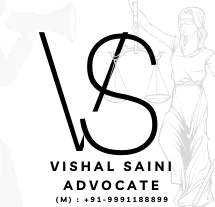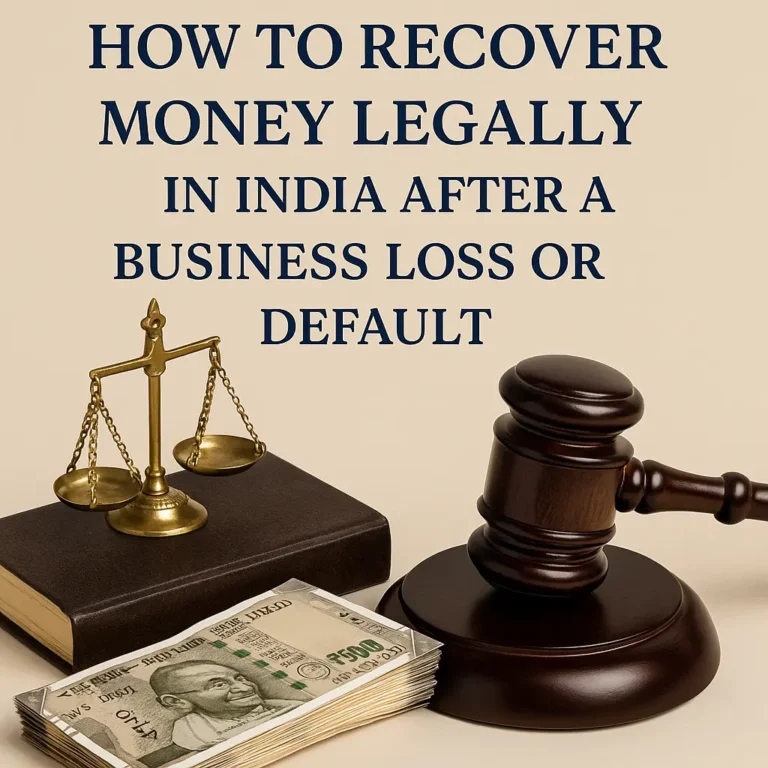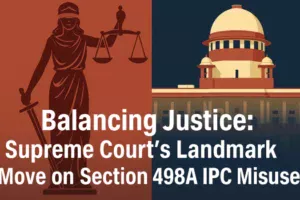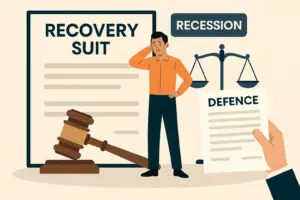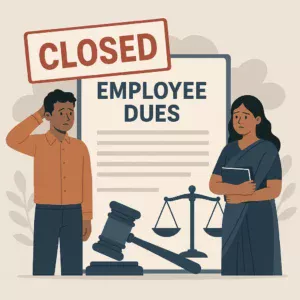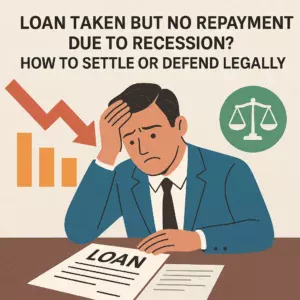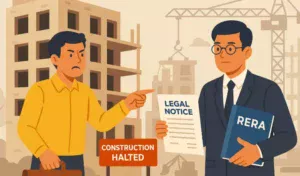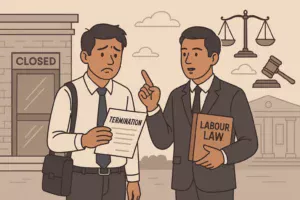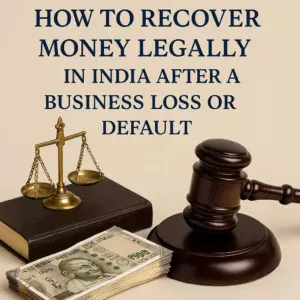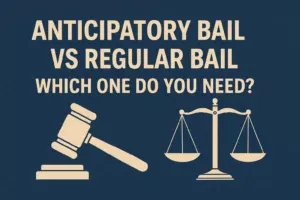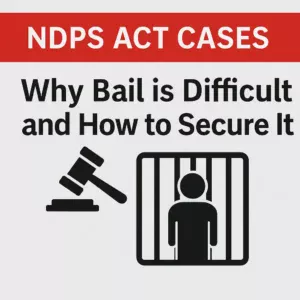Introduction
The economic aftershocks of a recession often lead to widespread payment defaults, especially among small businesses and traders. One common issue that resurfaces during such downturns is the bouncing of cheques due to insufficient funds.
But do you know that a bounced cheque is not just a financial setback – it’s a punishable offence under Indian law?
This article guides you through the legal remedies available under Section 138 of the Negotiable Instruments Act, including how to send a cheque bounce notice, and file a criminal case if necessary
⚖️ What is Section 138 of the Negotiable Instruments Act?
Section 138 of the Negotiable Instruments Act, 1881 deals with the dishonour of cheques. When a cheque issued by a debtor bounces due to insufficient funds, it is treated as a criminal offence.
🧾 Essentials of Section 138:
- A legally enforceable debt or liability must exist.
- The cheque must be presented within 3 months from the date on the cheque.
- Upon dishonour, a legal notice must be issued within 30 days.
- The drawer (payer) must pay within 15 days of receiving the notice.
- If not paid, you can file a criminal complaint within one month after the notice period ends.
💡 Why Cheque Bounce Cases Are Rising After Recession?
- Businesses are cash-strapped due to poor sales.
- Post-dated cheques issued during credit purchases are dishonoured.
- Debtors avoid communication, causing panic among creditors.
- Many are unaware of their legal rights and miss deadlines.
📬 How to Send a Legal Notice for Cheque Bounce
Sending a cheque bounce notice is the first and mandatory legal step under Section 138.
✅ Cheque Bounce Notice Format (Summary):
To:
[Name of the drawer]
[Address]Subject: Legal Notice under Section 138 of the Negotiable Instruments Act, 1881
Dear Sir/Madam,
You issued a cheque bearing no. ______ dated ______ for ₹______ drawn on ______ Bank in discharge of your liability. The cheque was presented but returned unpaid due to [Insufficient Funds/Account Closed] on ______.
You are hereby called upon to make payment of ₹______ within 15 days from receipt of this notice. Failure to do so shall compel us to initiate legal action under Section 138.
Yours truly,
[Name of the sender]
[Address]
[Date]
👉 Pro Tip: Send notice via registered post or courier with acknowledgment and retain tracking proof.
🧾 Documents Needed to File a Cheque Bounce Case
- Copy of the cheque
- Cheque return memo from the bank
- Copy of the legal notice sent
- Postal/courier receipt and acknowledgment
- Affidavit and complaint under Section 138
- Evidence of debt or liability (invoice, loan agreement, etc.)
🏛️ How to File a Case After Sending Notice
If no payment is made within 15 days of receipt of the notice:
Step-by-step Procedure:
- Draft a criminal complaint under Section 138.
- Attach supporting documents.
- File the complaint before the Judicial Magistrate First Class (JMFC) or Metropolitan Magistrate.
- Appear before the court for verification of complaint.
- The court will issue summons to the accused after prima facie satisfaction.
🔍 Timeline to Keep in Mind
| Action | Timeline |
|---|---|
| Cheque presentation | Within 3 months |
| Legal notice | Within 30 days of return |
| Payment period | 15 days from receipt of notice |
| Case filing | Within 1 month after 15-day notice period ends |
👨⚖️ Penalties Under Section 138
If convicted, the drawer may face:
- Up to 2 years imprisonment, or
- Fine up to twice the cheque amount, or
- Both
The complainant may also pursue civil recovery and interest through separate proceedings.
💬 Sample Cheque Bounce Complaint Language
“That the accused issued a cheque dated ___ bearing no. ___ drawn on ___ Bank towards discharge of debt. The same was dishonoured on presentation. Despite legal notice dated ___, no payment has been made. Hence, this complaint under Section 138 is filed…”
🛡️ Legal Help for Payment Default After Recession
If you’re a:
- Lender waiting on credit repayment,
- Shopkeeper with unpaid bills,
- Small business owner facing bounced cheques,
👉 Consult a lawyer immediately to draft notices, file complaints, and represent you in court.
Many RERA lawyers, civil recovery experts, and cheque bounce specialists now offer fixed-fee packages for these cases.
Tips to Protect Yourself From Future Cheque Bounce Cases
- Avoid taking cheques from unknown clients post-recession.
- Always document the underlying transaction (invoice, delivery note).
- Prefer digital payments or bank transfers.
- If accepting post-dated cheques, ensure credit terms are written.
Need Help?
If you’re dealing with cheque bounce, don’t wait for the other party to respond casually. Take legal action before time runs out.
✅For free cheque bounce notice templates, expert drafting help, or to file a Section 138 complaint, contact a legal professional near you.
FAQs: Cheque Bounce After Recession – Legal Remedies & Notice Format
GENERAL CONCEPTS
- What is cheque bounce?
A cheque bounce occurs when a bank returns a cheque unpaid due to reasons like insufficient funds, stop payment, or account closure. - Is cheque bounce a criminal or civil offence?
Cheque bounce under Section 138 of the Negotiable Instruments Act is a criminal offence, punishable with imprisonment or fine. - What is Section 138 of the NI Act?
It punishes the drawer of a dishonoured cheque if they fail to pay the amount within 15 days of receiving legal notice. - What are the key elements of Section 138 offence?
There must be:- A valid debt or liability,
- Dishonoured cheque,
- Legal notice served,
- No payment within 15 days.
- How is cheque bounce related to recession?
Post-recession, many businesses face financial strain, leading to payment defaults and cheque dishonours. - What is the punishment under Section 138?
Up to 2 years imprisonment, or fine up to twice the cheque amount, or both. - What are my rights if a cheque given to me bounces?
You can send a legal notice and file a criminal complaint under Section 138. - Can I sue for a bounced post-dated cheque?
Yes, if the cheque was issued to settle a legally enforceable debt. - Is oral agreement valid in cheque bounce cases?
Yes, if you can prove the debt through surrounding circumstances or documentary evidence. - What are common reasons for cheque bounce?
Insufficient funds, account closure, signature mismatch, overwritten cheque, stop payment instructions.
LEGAL NOTICE PROCES
- When should I send a cheque bounce legal notice?
Within 30 days from the date the bank returns the cheque unpaid. - What should a cheque bounce notice contain?
Details of the cheque, reason for dishonour, amount due, and a 15-day demand for payment. - How to send legal notice – post or email?
Send via registered post or speed post with acknowledgment; email alone may not be sufficient. - What happens if drawer doesn’t respond to notice?
If no payment is made within 15 days, you can file a criminal complaint in court. - What if the accused refuses the notice delivery?
Refusal to accept is treated as valid service (deemed service) under law. - Can I download a cheque bounce notice format online?
Yes, many legal websites offer free downloadable templates. - Is lawyer mandatory to send legal notice?
Not mandatory, but it is highly recommended to ensure proper language and format. - Can I WhatsApp the cheque bounce notice?
No. Legally accepted mode is physical delivery via post or courier. - Should I mention the cheque number and amount in the notice?
Yes, all cheque details must be clearly specified. - Can I send one notice for multiple bounced cheques?
If cheques are issued for the same transaction, then yes.
FILING A CASE UNDER SECTION 138
- What is the time limit to file a case after notice?
Within 30 days from the expiry of the 15-day notice period. - Where do I file a cheque bounce case?
In the Magistrate Court (JMFC or MM) where your bank is located (as payee). - What documents are required to file the complaint?
- Original cheque copy
- Return memo from bank
- Copy of legal notice
- Proof of delivery of notice
- Affidavit and complaint form
- Do I need to appear in court personally?
Yes, you must attend court for verification and further hearings unless represented by advocate with vakalatnama. - Is court fee required for cheque bounce case?
Yes, nominal court fee and stamp duty depending on your state. - Can I recover legal expenses from the accused?
Yes, the court may direct compensation including legal costs. - Can I file a case if cheque was given for loan repayment?
Yes, loans are legally enforceable debts, covered under Section 138. - How long does the cheque bounce case take?
Usually between 6 months to 2 years, depending on court pendency. - Can accused go to jail for cheque bounce?
Yes, if found guilty and unable to pay, court may sentence up to 2 years imprisonment. - Can I file civil suit along with criminal case?
Yes, you can simultaneously file civil recovery suit for principal and interest.
RECESSION-RELATED CHEQUE ISSUES
- What if cheque bounced due to recession-related losses?
Economic hardship does not excuse cheque bounce; Section 138 still applies. - Can recession be a legal defence?
No. Financial difficulty is not a valid legal defence under Section 138. - What if the drawer claims business failure?
The legal obligation to pay remains; court will consider intent and liability. - I gave goods on credit post-recession. Can I file case if cheque bounced?
Yes, if the debt is proven and cheque was issued in discharge of the amount due. - Is cheque bounce more common post-recession?
Yes, due to liquidity crunch and loan defaults, especially among small businesses. - Should I avoid accepting cheques post-recession?
Prefer digital or bank transfers. Cheques are risky without proper due diligence. - Can an NRI file cheque bounce case in India?
Yes, if the cheque was issued in India for a legally enforceable obligation. - What if cheque issued by a closed company?
You can sue the signatory or promoter, depending on the liability structure. - Is cheque bounce case maintainable if drawer dies?
No. Criminal liability dies with the person. Civil recovery may be pursued against estate. - Can I take police help for bounced cheque?
No. It’s not an FIR matter; you must file a private criminal complaint.
RECOVERY & COMPENSATION
- Can I recover interest on cheque amount?
Yes, either by filing civil suit or if the court awards compensation. - What if drawer wants to settle before trial?
You can compound the offence and file compromise before court. - What if drawer claims signature was forged?
The burden to prove forgery is on the accused; court may call for handwriting expert. - Can I issue notice to a company for cheque bounce?
Yes, and you must also send notice to the authorized signatory or director. - Can I file case without original cheque?
No. Original bounced cheque is essential evidence in court. - Can I withdraw the case later?
Yes, with court’s permission, especially in case of settlement or compromise. - Can I file RTI to know case status?
Yes, you may file RTI to the court or police (if involved) to get case movement details. - Can I file case against a minor who issued cheque?
No. Minors cannot be held criminally liable under Section 138. - What happens if drawer absconds during trial?
Court may issue bailable or non-bailable warrants, even proclaim him offender under Section 82 CrPC. - Is mediation possible in cheque bounce cases?
Yes. Many courts promote pre-litigation mediation or in-trial compromise under law.
